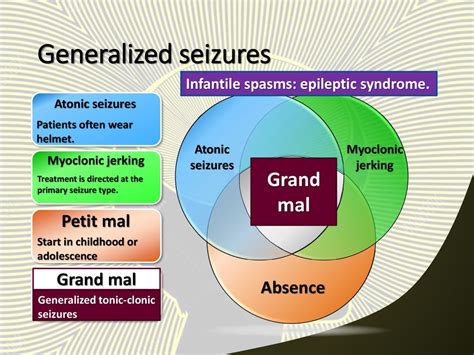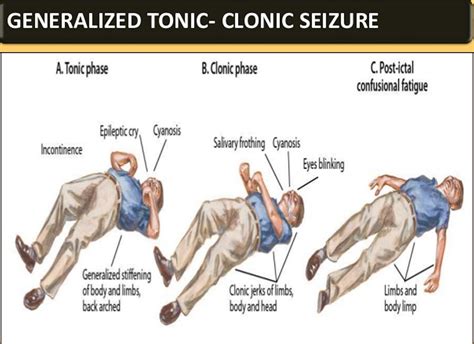Intro
Learn Grand Mal Seizure Symptoms, causes, and treatments. Identify tonic-clonic seizure signs, convulsions, and loss of consciousness to get medical help.
A grand mal seizure, also known as a tonic-clonic seizure, is a type of seizure that affects the entire brain. It is characterized by a loss of consciousness and convulsions, which can be quite frightening for those who experience them and for those who witness them. Grand mal seizures are often associated with epilepsy, a neurological disorder that affects millions of people worldwide. Understanding the symptoms of a grand mal seizure is crucial for providing proper care and treatment to those who experience them.
Grand mal seizures can occur at any time, and they can be triggered by a variety of factors, including stress, lack of sleep, and certain medical conditions. The symptoms of a grand mal seizure can be divided into several phases, including the aura phase, the tonic phase, the clonic phase, and the postictal phase. Each phase has distinct symptoms, and recognizing these symptoms is essential for providing proper care and treatment.
The importance of understanding grand mal seizure symptoms cannot be overstated. By recognizing the symptoms of a grand mal seizure, individuals can seek medical attention promptly, which can help to prevent complications and improve treatment outcomes. Additionally, understanding the symptoms of a grand mal seizure can help to reduce the stigma associated with epilepsy and other neurological disorders. By educating themselves about grand mal seizure symptoms, individuals can better support their loved ones who experience seizures and can help to create a more supportive and inclusive community.
What is a Grand Mal Seizure?

Symptoms of a Grand Mal Seizure
The symptoms of a grand mal seizure can be divided into several phases, including the aura phase, the tonic phase, the clonic phase, and the postictal phase. Each phase has distinct symptoms, and recognizing these symptoms is essential for providing proper care and treatment. * Aura phase: During this phase, the individual may experience a range of symptoms, including dizziness, nausea, and changes in vision or hearing. * Tonic phase: During this phase, the individual may experience muscle stiffness and convulsions, which can be quite intense. * Clonic phase: During this phase, the individual may experience rapid, rhythmic contractions of the muscles, which can be quite frightening for those who witness them. * Postictal phase: During this phase, the individual may experience confusion, disorientation, and changes in behavior.Causes of Grand Mal Seizures

Risk Factors for Grand Mal Seizures
There are several risk factors that can increase an individual's likelihood of experiencing a grand mal seizure. These risk factors include: * Family history: Individuals with a family history of epilepsy or seizures are more likely to experience grand mal seizures. * Age: Grand mal seizures can occur at any age, but they are most common in children and older adults. * Medical conditions: Certain medical conditions, such as diabetes and high blood pressure, can increase an individual's risk of experiencing a grand mal seizure. * Medications: Certain medications, such as antidepressants and antipsychotics, can increase an individual's risk of experiencing a grand mal seizure.Diagnosing Grand Mal Seizures

Treatment Options for Grand Mal Seizures
There are several treatment options available for grand mal seizures, including: * Medications: Medications can help to control the frequency and severity of grand mal seizures. They work by reducing the electrical activity in the brain that causes seizures. * Surgery: In some cases, surgery may be necessary to treat grand mal seizures. This can involve removing a portion of the brain that is responsible for causing seizures. * Lifestyle changes: Making lifestyle changes, such as getting regular exercise and reducing stress, can help to reduce the frequency and severity of grand mal seizures.Living with Grand Mal Seizures

Coping with Grand Mal Seizures
Coping with grand mal seizures can be challenging, but there are several things that individuals can do to manage their condition and improve their quality of life. These include: * Joining a support group: Joining a support group can provide individuals with a sense of community and connection, which can be helpful in managing grand mal seizures. * Seeking counseling: Seeking counseling can help individuals to cope with the emotional and psychological aspects of grand mal seizures. * Educating oneself: Educating oneself about grand mal seizures can help individuals to better understand their condition and to make informed decisions about their treatment.What is a grand mal seizure?
+A grand mal seizure is a type of seizure that affects the entire brain, characterized by a loss of consciousness and convulsions.
What are the symptoms of a grand mal seizure?
+The symptoms of a grand mal seizure include convulsions, loss of consciousness, and changes in behavior, and can be divided into several phases, including the aura phase, the tonic phase, the clonic phase, and the postictal phase.
How are grand mal seizures diagnosed?
+Grand mal seizures are diagnosed using a variety of tests, including electroencephalogram (EEG), magnetic resonance imaging (MRI), and computed tomography (CT) scan.
What are the treatment options for grand mal seizures?
+Treatment options for grand mal seizures include medications, surgery, and lifestyle changes, such as getting regular exercise and reducing stress.
How can individuals cope with grand mal seizures?
+Individuals can cope with grand mal seizures by joining a support group, seeking counseling, educating oneself, and making lifestyle changes, such as getting regular exercise and reducing stress.
If you or someone you know is experiencing grand mal seizures, it is essential to seek medical attention promptly. By understanding the symptoms and treatment options for grand mal seizures, individuals can better manage their condition and improve their quality of life. We encourage you to share this article with others who may be experiencing grand mal seizures, and to comment below with any questions or concerns you may have. Together, we can work to create a more supportive and inclusive community for individuals with grand mal seizures and other neurological disorders.
